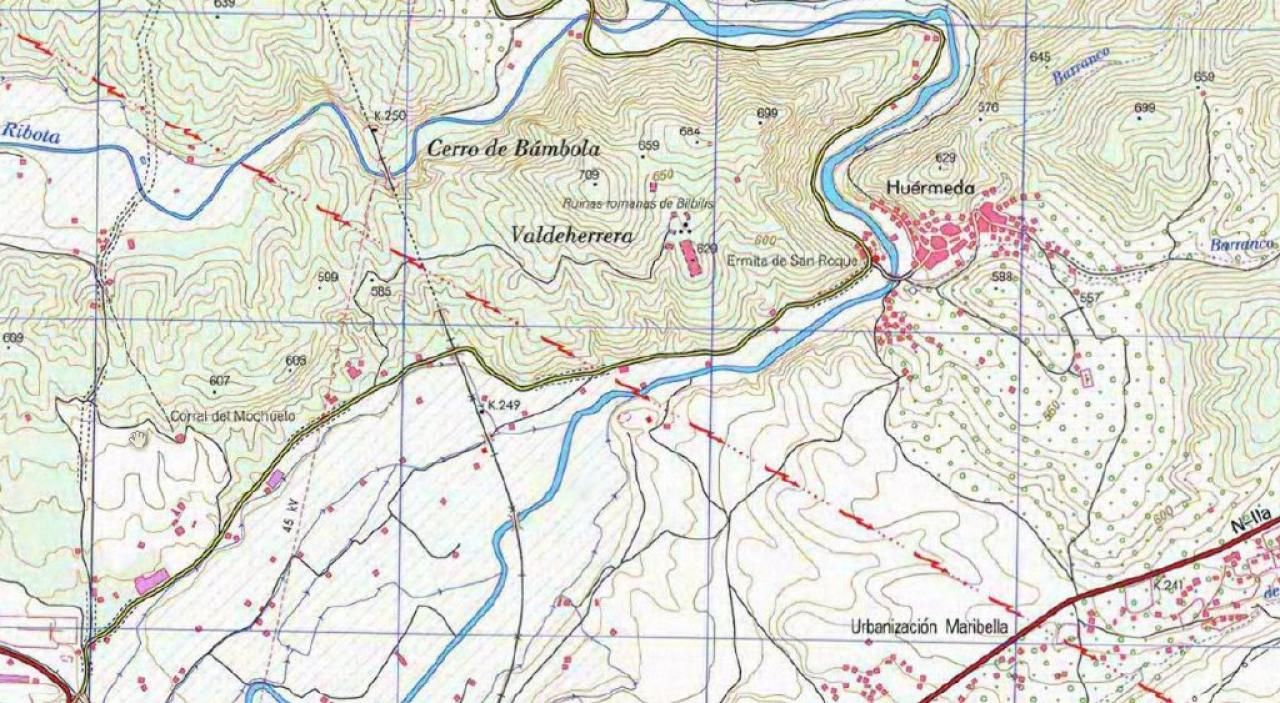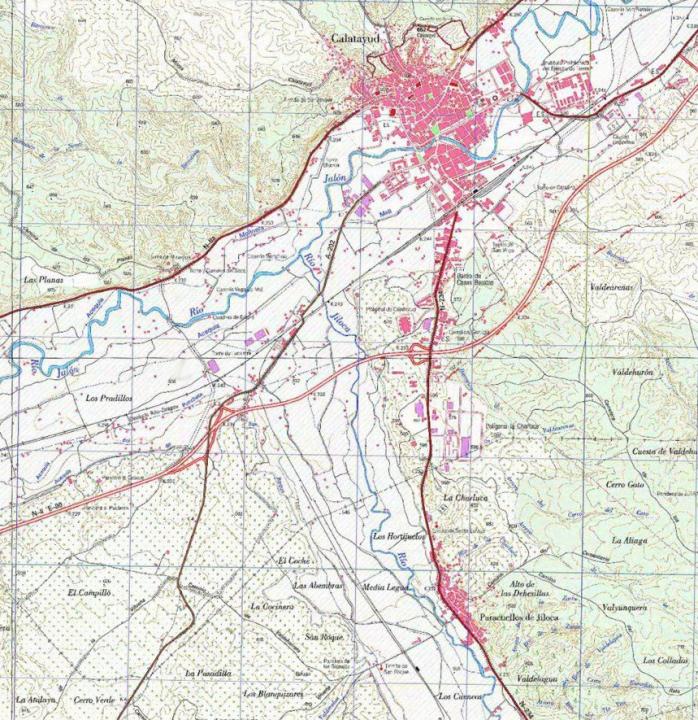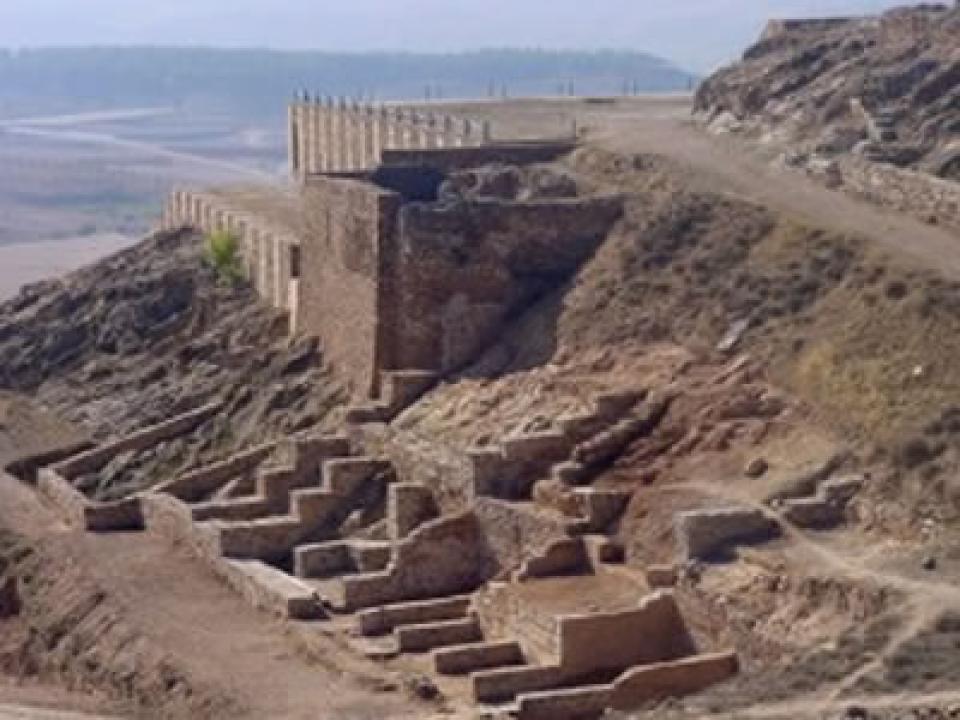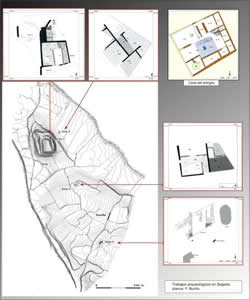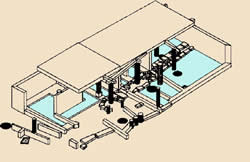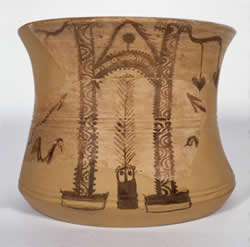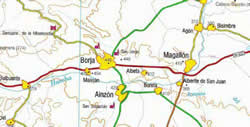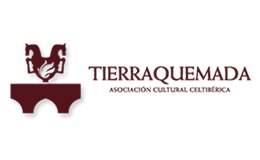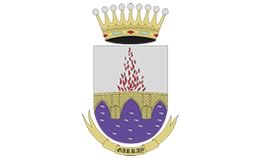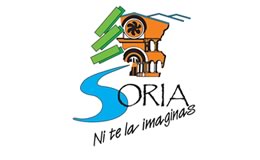

Quotes and referentes to the city of Bilbilis
This city appears mentioned later in the classical texts, Strabo makes it, making reference to a moment of the 1st century BC., related to the Sertorian wars (80-72 BC.), referring to Segobriga and Biblis as Celtiberian cities around which fought Metellus and Sertorius. The previous sources insist on its Celtiberian attribution, being attributed according some people to the Lusones and for others to the Belos
It is known bronze money (ases and semis) of Celtiberian metrology and typology, minted by this city from the half of the 2nd century BC., figuring, in the front, manly head with torques, dolphin in front, and the sign BI at the back and in the opposite, rider lancers or horse galloping with the legend Bibliz, under the animal.
The information that gives Plinius about Biblis connected to the Caesarugustano convent as the quotes of the itineraries corresponds already to the Roman city. Nevertheless in relation to this city it is necessary to highlight the information gave by Marcus Valerius Martial, born in Bilbilis, around the year 40 and that, after his stay in Rome, came back to his city (around 98 AD), transmitting us in his epigrams information about Bilbilis environment of his time.
It is known also money minting process of the Roman city, from Augustus who gave to the city the name of Municipium Augusta Bilbilis, issues money with the Latin legend of Bilbilis Italica continuing the minting process till Caligula.
Three Bilbilis?
It is known in the municipal term of Calatayud the location of three cities, in different places: two Celtiberians (Bilbilis I and II) and another of Roman epoch (Bilbilis III), without chronological overlap.
Bilbilis I:
Research works:
In these last years the works of urban archaeology carried out in the Historic Quarter of Catalayud by the General Direction of Cultural Wealth of the Government of Aragon, leaded by J. L. Cebolla could had documented the older Bilbilis.
• The older Bilbilis
The ruins of this Celtiberian city are under the Historic Centre of the present Calatayud. There are remains of this city in more than 15 solars that allows establishing an area for these finds that would achieve a surface of 16 hectares.
It would be an urban settlement in hillside, with several levels of neglect and violent destruction associated to several constructive phases and of extension of this nucleus, in which they discovered as domestic as of the defensive system of the city structures.
These works have allowed knowing, to a certain extent, the evolution of this first city of Bilbilis.
• it has been documented a stretch of the city wall and the moat of the primitive settlement (previous the 3rd century BC) in a second moment the moat was filled and the defensive wall was annulled and in a third time, on the fillers of the moat, were detected the ruins of isolated blocks of stone (end of the 3rd century and beginning of the 2nd century BC).
• the fourth phases is the moment of maximum expansion of the urban part when the moat was totally filled and levelled and hosted new constructive spaces, distributed in housings and streets.
It could have known also ruins of the wall and moat of this city that extends towards Jalon River. It was documented a powerful level of destruction in which they had got back ruins of ceramic that permit to date this moment to half of the 2nd BC. coinciding with the Second Celtiberian War (153-133 BC.).
Problems of location of Bilbiliz (Bilbilis II)
Before knowing Bilbilis I, in 80s it had been considered the problem that the Celtiberian Bilbilis was not under the known Italic Bilbilis, how people believe.
In this sense, the archaeological team leaded by M. Martin Bueno, who excavates in the hill of Bambola, according to the traditional opinion thinks that the Celtiberian Bilbilis is under the Italic Bilbilis of Roman Imperial epoch, since in his works found systematically ruins of the Celtiberian town planning, under the excavated zones of the Roman city
But F. Burillo and M. Ostale (1983-1984) set out that the Celtiberian Bilbilis (that of texts and money) has to locate in the site of Valdeherrera (Calatayud) that occupies the bank of Jiloca River in its intersection with the Jalon, distant about 8km from the hill of Bambola, arguing that it has form of city as its extension, more than 20 hectares, as for the information that give some archaeological materials
In this sense, it would support this location, the finds of two bronze tokens which indicate that in Valdeherrera it was minted coin. For this reason it had to be one of the Celtiberian mints known in the zone of the jalon. Moreover, among the found coins, a major percentage corresponds to the mint of Bilbiliz.
To the entire interior does join the limited distance exist between both places that come into contradiction with the space methodology since it can not exist two cities so near. All that advises to give different location to the Celtiberian older city of Bilbiliz, in Valdeherrera and to the more modern Italic Bilbilis in the hill of Bambola.
Bilbiliz (Valdeherrera)
Situation and location:
This city is located in the place of Valdherrera, end of Calatayud, occupying the extreme of a flat spur, in the union of the River Jiloca with the River Jalon, controlling the alluvial plain made up of these two rivers.
Works of research:
The site of Valdeherrera was known from much time in the Aragonese archaeology since Lopez Sampedro is the first that gives information with some details (1968). But he did not concentrate his interest on it of the archaeological research till 80s of the last century, from that A. Dominguez and P. Galindo (in the National Congress of Archaeology of 1983) invent the materials of this site, specially thestudy of its coins, gave new basis to focus the attention in this site. They will be F. Burillo and M. Ostale (1983-1984) basing on the information given by the previous work and others new, those who will present the necessary arguments to locate the Celtiberian Bilbilis in this site.
The works of research and archaeological excavations began in this site from 2006 by the interdisciplinary team of the Universities of Zaragoza and Burdeos, leaded by M. Martin Bueno, Carlos Saenz and Sophie Krausz.
Characteristics of the settlement:
It is a city in plain with more or less triangular shape with a major axis of about 800m and a surface of about 9 hectares. It is possible to appreciate from its more accessible side a big moat of about 44m of width and to notice the ruins of the city wall. The works of excavation has begun to discover ruins of the city as the Southern door built with ashlars of plaster of big size.
Chronology:
The materials give a wide chronology from the 3rd century BC. The moment of maximum coin circulation is marked by the 2nd century and the first half of the 1st BC. The date for the end of Celtiberian occupation is marked by Sertorian wars (80-72 BC.), since the cities of Ebro Valley, in these civil wars, took sides for Serotius, who was defeated by Pompey.
Italic Bilbilis (Hill of Bambola)
How do you get?
To the ruins of Italic Bilbilis get coming in Calatayud and taking direction Soria, to about 6km in the Hill of Bambola. Gone beyond the cemetery, to about 400m, arrive at a traffic circle where take the first exit that takes to Embid, where it is indicated the site. Before to arrive in Huermeda a cartel marks the asphalted route that leads to a little establishment next to the centre of interpretation, from there, to continue on foot through the route signposted till the zone of theatre and follow the established itinerary
To the ruins of Italic Bilbilis get coming in Calatayud and taking direction Soria, to about 6km in the Hill of Bambola. Gone beyond the cemetery, to about 400m, arrive at a traffic circle where take the first exit that takes to Embid, where it is indicated the site. Before to arrive in Huermeda a cartel marks the asphalted route that leads to a little establishment next to the centre of interpretation, from there, to continue on foot through the route signposted till the zone of theatre and follow the established itinerary.
Situation and location:
The city settled down in the inclined hillside of the hill of Bambola, constituted by three tops, that own of the name (709m) that of St Paterno (701m) and St Barbara (629m). It is to about 5km of Calatayud, in the end of Huermeda, small town of Calatayud. The hill stands out to about 200m above the bed of the Jalon River that surrounds it and to which it is join the Ribota through its Northern side.
Works of research:
The first known excavations were realized by the Count of Samitier, between 1900 and 1910 with the materials that his archaeological adventures through the region made up a collection of which it is kept only a little part in the Provincial Museum of Zaragoza. More interesting were the surveys made by Narciso Sentenach in 1917 published in the Memories of the Superior Committee of Excavations and Antiquities (1918). In 1933, Adolfo Schulten realized little surveys and explorations with the general Lammerer without discovering anything new.
The modern and systematic stage of the excavations, till the present moment, began in 1971 by an archaeological team leaded by Manuel Martin Bueno that gave knowledge that nowadays we have about the Roman city. It was carried out with the excavations a work of consolidation, covering of some buildings and itinerary of sightseeing.
Characteristics of the Roman city:
It will be in Augustus epoch (it has been found recently the head of a sculpture) when they carried out the administrative reforms that will transform Italic Bilbilis in a big Roman city, included in the Legal Caesaraugustan Convent, in the framework of Tarragon province, to the city it is given the status of town council, passing to be called Municipium Augusta Bilbilis, that would confer it the full right and the Roman citizenship.
The city occupied about 30 hectares and set to the land characteristics through a complex building action, that supposed to adapt it through a huge work of terrace buildings to the hardness and incline that demanded the wide hill. The excavations gave the opportunity to discover the monumentality that had the city to perform the role that had entrusted:
In the acropolis, court, for which it was built an incredible and monumental balcony, with portico square, temple, basilica and curia, constituting next to the theatre, that makes the most of the gully for the grandstand, a same whole. Near to the thermal complex, the nymphaeum and several private buildings, as some insulae or blocks of houses next to the thermal baths and a big public building.
It is necessary to highlight the complex hydraulic net adapted to the topographic complexity of the city to solve the water supply through cisterns of semicircular vault, realized with “opus caementicium” that give them impermeable state, located in the curves of level adapted to satisfy the necessities of the different zones of the city.
Several ruins and objects of the Roman city are kept in the Museum of Calatayud.
Centre of interpretation:
Before to begin the tour through the site it is advisable to see the centre of interpretation, next to the parking since it gives the necessary information to understand better the sightseeing to the city.
It is a building with Roman design and references, in which eight exhibition panels have been installed; in them it is explained the history of the city and the principle monuments that previously you could see in the site.
Bibliography
Bilbilis I:
- Royo, J.I.; Cebolla, J.L. (2005): La búsqueda de la Bilbilis celtiberica. En A. Jimeno (ed.): CELTIBEROS. Tras la estela de Numancia, Soria, Salamanca.
Celtiberian Bilbilis:
- Galindo, P.; Dominguez, A. (1985): El yacimiento celtibero-romano de Valdeherrera (Calatayud, Zaragoza). XII Congreso Nacional de Arqueologia, (Logroño, 1983), Zaragoza.
- Burillo, F., Ostale, M. (1983-1984): Sobre la situacion de las ciudades celtibericas Bilbilis y Segeda, Kalathos, 3-4.
-Bilbilis Italica:
- Sentenach, N. (1918): Excavaciones en Bilbilis (Cerro de Bambola, Calatayud). Memoria de las explotaciones y excavaciones practicadas en el año 1917. Junta Superior de Excavaciones y Antigüedades, 3, Madrid.
- Martin Bueno, M. (1975): Bilbilis. Estudio Historico Arqueologico, Zaragoza.
- Martin Bueno, M. (2000): Bilbilis Augusta, CAI 100, Zaragoza.
Contacts and visiting hours:
- Link in the Web Office of Tourism Plaza del Fuerte: (+34) 976886322
- oficinaturismo@calatayuddigital.net
Visiting hours:
- Holy Week from 6p.m. to 7p.m. and during the summer from 5p.m. to 8p.m.


